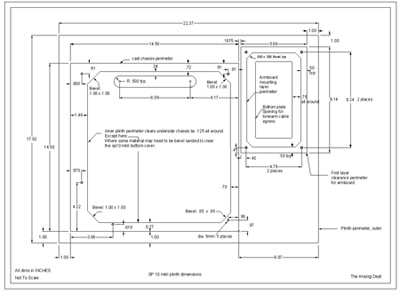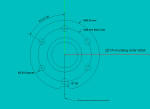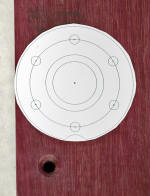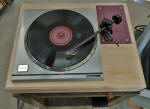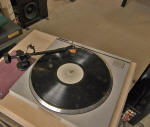-edible zone-
Early Listening
some plinth design renders.
1) light
weight. layered baltic birch plywood builds
Still working on
final details for this design.
notes:
This plinth will
allow either one 12 inch tonearm or one 9 inch toneam to be mounted.
Presumably, any effective length arm in between these extremes will work
as well. but I plan on first a 9 inch tonearm; the black Zeta. Then,
over time, I will explore other tonearms/cartridges to see where the
turntable's strengths are.
Stacked multi-layer baltic birch
plywood.
I plan on making the first armboard out of purple heart. More details later as I develop them.
 concept 5, light-medium-heavy. This is the same basic build but
with medium and heavy versions using more layers.
concept 5, light-medium-heavy. This is the same basic build but
with medium and heavy versions using more layers.
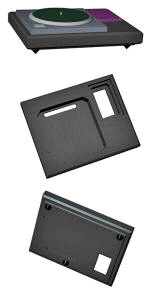 concept 5, light version, 3 views. Thickness this version is 3
inches. Top to bottom plate.
concept 5, light version, 3 views. Thickness this version is 3
inches. Top to bottom plate.
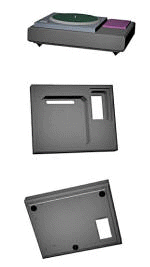 concept 5, medium weight version, 3 views. Thickness this version is 4
inches, top to bottom plate.
concept 5, medium weight version, 3 views. Thickness this version is 4
inches, top to bottom plate.
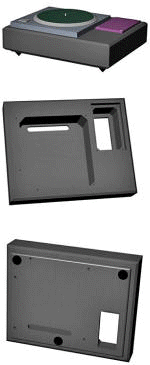 concept 5, heavy weight version, 3 views. Thickness this version is 5
inches, top to bottom plate.
concept 5, heavy weight version, 3 views. Thickness this version is 5
inches, top to bottom plate.
here is a top view dimensional
layout:
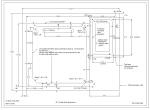 click on thumbnail to view full sized.
click on thumbnail to view full sized.
Link to pdf of the dimensioned drawing. Adobe Reader required.
Please note. Above drawing is readable on 11 x 17 (US B size) plot.
If you can't print to 11 x 17, use the 'snap shot' feature in
Adobe Reader to split the drawing into two separate 8-1/2 x 11 prints to
improve readability.
___________________________________________________________________horizontal rule
The first plinth built is the heavy version. The more I thought about
it, the more it seemed logical. .
At this stage, the plinth is complete in its
glue-up but still requires much sanding before finish coating can begin.
The purpose for this session is to check for fit of the sp10 mkII motor
unit within the plinth, and also to fit the tonearm board , then layout
for the drilled hole locations to mount the tonearm.
Laying out the tonearm mount.
*The pivot to spindle distance for the Zeta tonearm is 210.6mm. ( 8.2913 inches) Using the Clearaudio protractor, 210.6 is set on the scale and a 210.6 mm radius arc is scribed across the tonearm board. Anywhere on this arc will correctly set pivot to spindle distance. But we also need to consider a more optimal location of the arm relative to the rest of the turntable. In this case, because the SP10 mkII is a really large TT that was designed for a 10 inch effective length tonearm (as opposed to the 9 inch effective length of this Zeta) there isn't very much room to fit the tonearm without its mounting flange touching the side of the SP10 mkII chassis. As it turns out, there is just enough room to accommodate the Zeta and its 2.375 "dia mounting flange.
* (click thumbnail for full size image)
(click thumbnail for full size image)
The one good thing about the Clearaudio protractor....it works as a layout tool for custom tonearm mounting. Very well, actually. I bought mine when they were new and could be had for approx. $150 usd.
 Look close and you can see the center punch for the main drill, but also
a 2.375 dia is drawn around it in pencil using a drafters compass. This
measure insures that all parts of the tonearm will fit the area. Just
barely.
Look close and you can see the center punch for the main drill, but also
a 2.375 dia is drawn around it in pencil using a drafters compass. This
measure insures that all parts of the tonearm will fit the area. Just
barely.
 Tools in use. A 5/32 inch transfer punch just fits the the Clearaudio
tool and serves as both scribe for making the arc, and punch for marking
the drilled hole start. The compass lays out for the mounting flange of
the Zeta tonearm to allow us to see that it will fit the area. A
machinists rule to set the compass diameter.
Tools in use. A 5/32 inch transfer punch just fits the the Clearaudio
tool and serves as both scribe for making the arc, and punch for marking
the drilled hole start. The compass lays out for the mounting flange of
the Zeta tonearm to allow us to see that it will fit the area. A
machinists rule to set the compass diameter.
 an alternate effective length considered but not used. The 228.6mm
effective length, with 18mm overhang listed in the owner's guide will
work in this application.
an alternate effective length considered but not used. The 228.6mm
effective length, with 18mm overhang listed in the owner's guide will
work in this application.
I can never resist a chance to listen to the rig before everything is
done. There's this need to know.
In the above photo one can see
the site method as well as the downstream components. I have three Lp
spinners using MC cartridges of similar load resistance requirements.
They all plug into the 1:10 step up transformer that feeds the
multiplied signal into a Wright WPP100C phono preamp, which in turn
sends its line level signal to the Classe' CAP 151 integrated stereo
amplifier. The processed and amplified signal is then sent to a pair of
NHT 2.9 floor standing loud speakers.
Both the SP10 mkII and the
Thorens TD124 are using Denon DL-103R low output MC cartridges. Both of
these cartridges have been installed into custom exotic wood bodies sold
to me by Uwe. The difference however is in the DL-103R mounted to the
SP10 mkII. This Denon has been re-tipped at Soundsmith with a Ruby
cantilever/Fine-Line diamond stylus. The Denon in the Thorens still uses
the stock tubular aluminum cantilever and conical diamond stylus. The
Denon in the SP10 mkII uses a Panzerholz body by Uwe. The one in the
Thorens uses an Ebony body by Uwe. There are differences in sound
quality between these two Denons because of the different
cantilever/stylii and also to a lesser extent because of the different
exotic wood bodies.
Impressions:
Further notes on early
listening.
JCarr's suggestion to move the phono cable ground from the
stud on the SUT to the stud on the phono preamp works out.
Naturally.
The change was not huge, but definitely real and for
the better. Improved focus, ambience and tone. Slight, but audible and
beneficial. Thanks Jon. Drop by and tune my system up any time you like
Other notes:
I think I'll listen to the turntable a few more
weeks while I sort out some other non-audio related tasks to be
accomplished.
What is noteworthy about the above sentence is that
I'm willing to continue listening to this turntable. It does have some
very nice attributes. I would include among its strengths terms like
focus, detail (macro and micro), tone quality and very, very good
timing.
The very good timing manifests itself by fleshing out
those brief, soft, quick passages with a more precise articulation of
it. This adds to the whole a greater sum than might otherwise be heard.
This particular Technics adds very good texture to the musical picture,
is what I'm trying to say.
So I find myself listening to the
classical side of my Lp library with this TT. Partly this is because the
SP10 mkII seems very good at rendering classical music but partly
because it doesn't quite produce the same amount of energy output on
sixties/seventies rock as does my TD124 that stands near it.
In
contrast, the TD124, an idler design from the late 1950's, has that
ability to make the leading edge of notes seem to leap forward with a
powerful sense of immediacy. To put it in different terms, the Thorens can
cause my feet to move involuntarily with its strong energy output while
the Technics would having me simply tapping those same feet to the same
track.
But I'm not going to call the Technics laid back by any
means. Compared to my TD150, it is more punchy and slammy. But compared
to the TD124, it can't match that level of slam and visceral sense of
drive.
I'm at a loss to explain why this is. The Technics platter
is propelled by a motor with a much higher amount of available torque
than is that of the TD124. Yet the Thorens defeats it in terms of energy
output.
On the other side of this coin, the Technics defeats the
Thorens in terms of detail and focus.
But this brings me back to
something I'm willing to accept; different record players for different
records....and I'm not going to ditch either the Thorens or the Technics
any time soon.
In the fullness of time, such as is allowed, I will do a complete
disassembly and refurb of the SP10 mkII. I'll document it with plenty of
photos as I have done on my TD124 projects. I'm just not going to dive
in right away. No need. Things are working quite well for the moment.
_______________________________________________________________horizontal rule
Just a short note to say that this rig is exceptionally good with
The Moody Blues. In fact the turntable is more articulate than I am
because I just discovered that I'm not finding the words I need to
describe what is working well on these rock records from the psychedelic
era. Clean tone. Sharp articulation. Driving rhythm. Deep bass. Clean
highs.
Last week I played one side of the Pink Floyd Wish You
Were Here album. The side with "Shine On You Crazy Diamond". It had me
leaning back in the listening chair , closing my eyes and taking the
ride. Sorry. I've no analysis but - just to say - that I was able to get
lost in that music. Good stuff
 11-06-2011. Still playing it. All good.
11-06-2011. Still playing it. All good.
Back to: The Mule Project page
